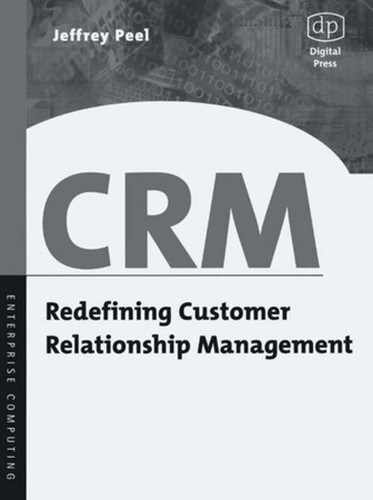
8.2 Departmental and suite-based solutions 121
8.2
Departmental and suite-based solutions
Under the auspices of purchasing a "departmental solution," many corpora-
tions purchase software solutions to speed up rather than change internal
processes. On the surface, this approach to CRM has a great deal of appeal.
The departmental scale tends to create the illusion that the ticket price is lower
for what are seen to be tactical, fix-it-now solutions. With time, the cost
of purchasing solutions using what I'll term "the departmental method"
becomes quite high. The net result might be that an enterprise maintains a
multitude of solutions that are disparate, often difficult to integrate, and pos-
sibly underused.
Let's be clear about one point. As much as I long for an idealistic world in
which all software selection is made not only with a company's strategic objec-
tives in mind, but with improvements in brand equity as the overriding goal,
the current tight economy imposes certain realities. As my friends within the
analyst community have been quick to point out, the economic downturn has
caused companies to focus increasingly on financial measures~return on
investment (ROI), in particular. Line managers need quick, financial justifi-
cation for their purchasing decisions and look for low price points and opera-
tional cost savings to justify these purchases. In some respects this approach
favors the departmental method. The individual price points for the depart-
mental solutions are typically much lower; thus, financial justification is easier
to find.
Seeking ROI is a reality, however. It can also be a good exercise when
done correctly; still, we must also remember that brand has economic value as
well. Senior management should insist that all ROI demonstrate an improve-
ment in brand engagement that can be measured empirically. How does the
line manager do this? He or she ties the resulting performance improvements
to customer engagement or value. In general, meeting or exceeding customer
expectations should always be the goal of CRM. It is the only thing that will
add real value to the company and make CRM work.
Vendors of suite-based solutions such as Siebel, Oracle, and e.Piphany
have recently taken advantage of this argument to push their prospects toward
their solutions, saying that although the solutions are more expensive to
implement initially, with time the cost savings that result from ease of integra-
tion of point components will offset the initial cost outlay. This is a seductive
argument to be certain but one that should be viewed as specious upon closer
investigation.
I Chapter 8
..................Content has been hidden....................
You can't read the all page of ebook, please click here login for view all page.
